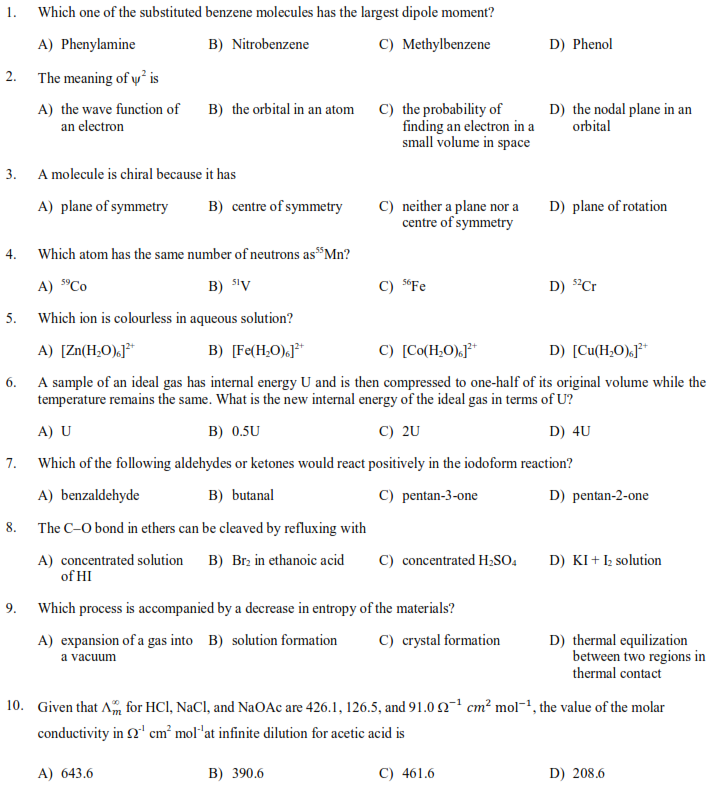|
#2
10th March 2016, 03:32 PM
| |||
| |||
| Re: Viteee Chemistry
VIT University has formally declared the VITEEE 2016 Syllabus. The college has unmistakably put points secured under every subject for VITEEE Syllabus. Competitors trying to show up in the VIT Engineering Entrance Examination 2016, are encouraged to experience the Syllabus for VITEEE minutely to know the themes to be secured under a specific subject. VITEEE Exam Pattern- Exam Timings: 2.30 Hours Exam Type: Multiple Choice Questions (MCQs) Exam medium: English The syllabus for the VITEEE examination for Chemistry Subject is as follows: VITEEE Syllabus 2016 for Chemistry Atomic Structure Bohr’s atomic model-Sommerfeld’s extension of atomic structure; Electronic configuration and Quantum numbers; Shapes of s,p,d,f orbitals – Pauli’s exclusion principle – Hund’s Rule of maximum multiplicity – Aufbau principle. Emission spectrum, absorption spectrum, line spectra and band spectra; Hydrogen spectrum – Lyman, Balmer, Paschen, Brackett and Pfund series; de Broglie’s theory; Heisenberg’s uncertainty principle – wave nature of electron – Schrodinger wave equation (No derivation). Eigenvalues and eigenfunctions. Hybridization of atomic orbitals involving s,p,d orbitals. P, d and f – Block Elements p-block elements – Phosphorous compounds; PCl3, PCl5 – Oxides. Hydrogen halides, Inter halogen compounds. Xenon fluoride compounds. General Characteristics of d – block elements – Electronic Configuration – Oxidation states of first row transition elements and their colours. Occurrence and principles of extraction: Copper, Silver, Gold and Zinc. Preparation, properties of CuSO4, AgNO3 and K2Cr2O7. Lanthanides – Introduction, electronic configuration, general characteristics, oxidation state – lanthanide contraction, uses, brief comparison of Lanthanides and Actinides. Coordination Chemistry and Solid State Chemistry Introduction – Terminology in coordination chemistry – IUPAC nomenclature of mononuclear coordination compounds. Isomerism, Geometrical isomerism in 4-coordinate, 6-coordinate complexes. Theories on coordination compounds – Werner’s theory (brief), Valence Bond theory. Uses of coordination compounds. Bioinorganic compounds (Haemoglobin and chlorophyll). Lattice – unit cell, systems, types of crystals, packing in solids; Ionic crystals – Imperfections in solids – point defects. X-Ray diffraction – Electrical Property, Amorphous solids (elementary ideas only). Thermodynamics, Chemical Equilibrium and Chemical Kinetics I and II law of thermodynamics – spontaneous and non spontaneous processes, entropy, Gibb’s free energy – Free energy change and chemical equilibrium – significance of entropy. Law of mass action – Le Chatelier’s principle, applications of chemical equilibrium. Rate expression, order and molecularity of reactions, zero order, first order and pseudo first order reaction – half life period. Determination of rate constant and order of reaction . Temperature dependence of rate constant – Arrhenius equation, activation energy. Electrochemistry Theory of electrical conductance; metallic and electrolytic conductance. Faraday’s laws – theory of strong electrolytes – Specific resistance, specific conductance, equivalent and molar conductance – Variation of conductance with dilution – Kohlrausch’s Law – Ionic product of water, pH and pOH – buffer solutions – use of pH values. Cells – Electrodes and electrode potentials – construction of cell and EMF values, Fuel cells, Corrosion and its prevention. Isomerism in Organic Compounds Definition, Classification – structural isomerism, stereo isomerism – geometrical and optical isomerism. Optical activity- chirality – compounds containing chiral centres – R – S notation, D – L notation. Alcohols and Ethers Nomenclature of alcohols – Classification of alcohols – distinction between 1°, 2° and 3° alcohols – General methods of preparation of primary alcohols, properties. Methods of preparation of dihydric alcohols: Glycol – Properties – Uses. Methods of preparation of trihydric alcohols – Properties – Uses. Aromatic alcohols – preparation and properties of phenols and benzyl alcohol. Ethers – Nomenclature of ethers – general methods of preparation of aliphatic ethers – Properties – Uses. Aromatic ethers – Preparation of Anisole – Uses. Carbonyl Compounds Nomenclature of carbonyl compounds – Comparison of aldehydes and ketones. General methods of preparation of aldehydes – Properties – Uses. Aromatic aldehydes – Preparation of benzaldehyde – Properties and Uses. Ketones – general methods of preparation of aliphatic ketones (acetone) – Properties – Uses. Aromatic ketones – preparation of acetophenone – Properties – Uses, preparation of benzophenone – Properties. Name reactions; Clemmensen reduction, Wolff – Kishner reduction, Cannizzaro reaction, Claisen Schmidt reaction, Benzoin Condensation, aldol Condensation. Preparation and applications of Grignard reagents. Carboxylic Acids and their derivatives Nomenclature – Preparation of aliphatic monocarboxylic acids – formic acid – Properties – Uses. Monohydroxy mono carboxylic acids; Lactic acid – Synthesis of lactic acid. Aliphatic dicarboxylic acids; Preparation of oxalic and succinic acid. Aromatic acids; Benzoic and Salicylic acid – Properties – Uses. Derivatives of carboxylic acids; acetyl chloride (CH3COCl) – Preparation – Properties – Uses. Preparation of acetamide, Properties – acetic anhydride – Preparation, Properties. Preparation of esters – methyl acetate – Properties. Organic Nitrogen Compounds and Biomolecules Aliphatic nitro compounds – Preparation of aliphatic nitroalkanes – Properties – Uses. Aromatic nitro compounds – Preparation – Properties – Uses. Distinction between aliphatic and aromatic nitro compounds. Amines; aliphatic amines – General methods of preparation – Properties – Distinction between 1°, 2° and 3° amines. Aromatic amines – Synthesis of benzylamine – Properties, Aniline – Preparation – Properties – Uses. Distinction between aliphatic and aromatic amine. Aliphatic nitriles – Preparation – properties – Uses. Diazonium salts – Preparation of benzene diazoniumchloride – Properties. Carbohydrates – distinction between sugars and non sugars, structural formulae of glucose, fructose and sucrose, with their linkages, invert sugar – definition, examples of oligo and polysaccharides, Amino acids – classification with examples, Peptides-properties of peptide bond, Lipids – Definition, classification with examples, difference between fats, oils and waxes VITEEE Sample Question Paper for Chemistry – Set 1  |